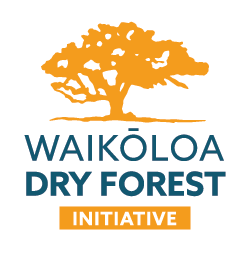This past August, a wildfire burned a total of 18,000 acres in South Kohala and…
Summer happenings
 This summer has been full of excitement and change at Waikoloa Dry Forest. We said a reluctant goodbye to our summer intern Jake who is now heading back to school in Ithaca, New York but are excited to welcome a new intern this fall. We are also looking forward to welcoming back the Waikoloa Future Foresters this coming weekend, it should be another fun year! With the help of our summer HYCC team and Ke Kama Pono we have made a lot of progress on our fuel break and created a number of trails throughout the project that will help us to better manage our out-planting sites and make it a little easier for visitors to get around the forest. We have installed irrigation lines and now have water flowing at the site. The need to haul in water had been limiting the number of individuals that we could out-plant at the site; we are looking forward to increasing our planting as we head into what will hopefully be a wet winter this year! Our on-site nursery was also built this summer. Thanks to Justin Branco and Big Country Fencing, we now have a shade-house in which to propagate and care for our native plants until they are ready to out-plant. We are very excited to move into our new nursery!
This summer has been full of excitement and change at Waikoloa Dry Forest. We said a reluctant goodbye to our summer intern Jake who is now heading back to school in Ithaca, New York but are excited to welcome a new intern this fall. We are also looking forward to welcoming back the Waikoloa Future Foresters this coming weekend, it should be another fun year! With the help of our summer HYCC team and Ke Kama Pono we have made a lot of progress on our fuel break and created a number of trails throughout the project that will help us to better manage our out-planting sites and make it a little easier for visitors to get around the forest. We have installed irrigation lines and now have water flowing at the site. The need to haul in water had been limiting the number of individuals that we could out-plant at the site; we are looking forward to increasing our planting as we head into what will hopefully be a wet winter this year! Our on-site nursery was also built this summer. Thanks to Justin Branco and Big Country Fencing, we now have a shade-house in which to propagate and care for our native plants until they are ready to out-plant. We are very excited to move into our new nursery!
Wiliwili update:

After a really dry winter, many of the wiliwili trees in WDF flushed few, if any, leaves. The flowering season, which began in early June at WDF, is also a little less dramatic than in previous years. This means that we don’t expect a very good seed year either. As part of our ongoing efforts to monitor the effects of the Erythrina gall wasp (EGW) on the wiliwili trees we have been keeping a close eye on those trees that have flowered and are looking for signs of the gall wasp. So far many of the flowers have been able to produce seeds but others are unable to develop because of severe galling. We are grateful to our partners (Department of forestry and Wildlife, Hawaii Department of agriculture and UH Manoa) on this project that continue to monitor EGW statewide and assess the effects of the predator wasp that was released as a bio-control at WDF in 2008. As we continue this monitoring it is clear that the trees are still being adversely affected by the EGW; we lose several trees each year at WDF likely from added stress due to the EGW. We continue to collect seeds, propagate and plant wiliwili within our protected forest. If you would like more information on how you can help plant wiliwili trees please contact and consider a volunteer day or a tour to the site and consider adopting a tree within the WDF.


This Post Has 0 Comments